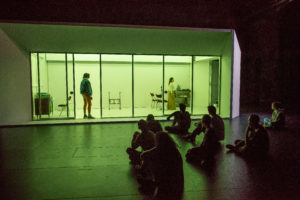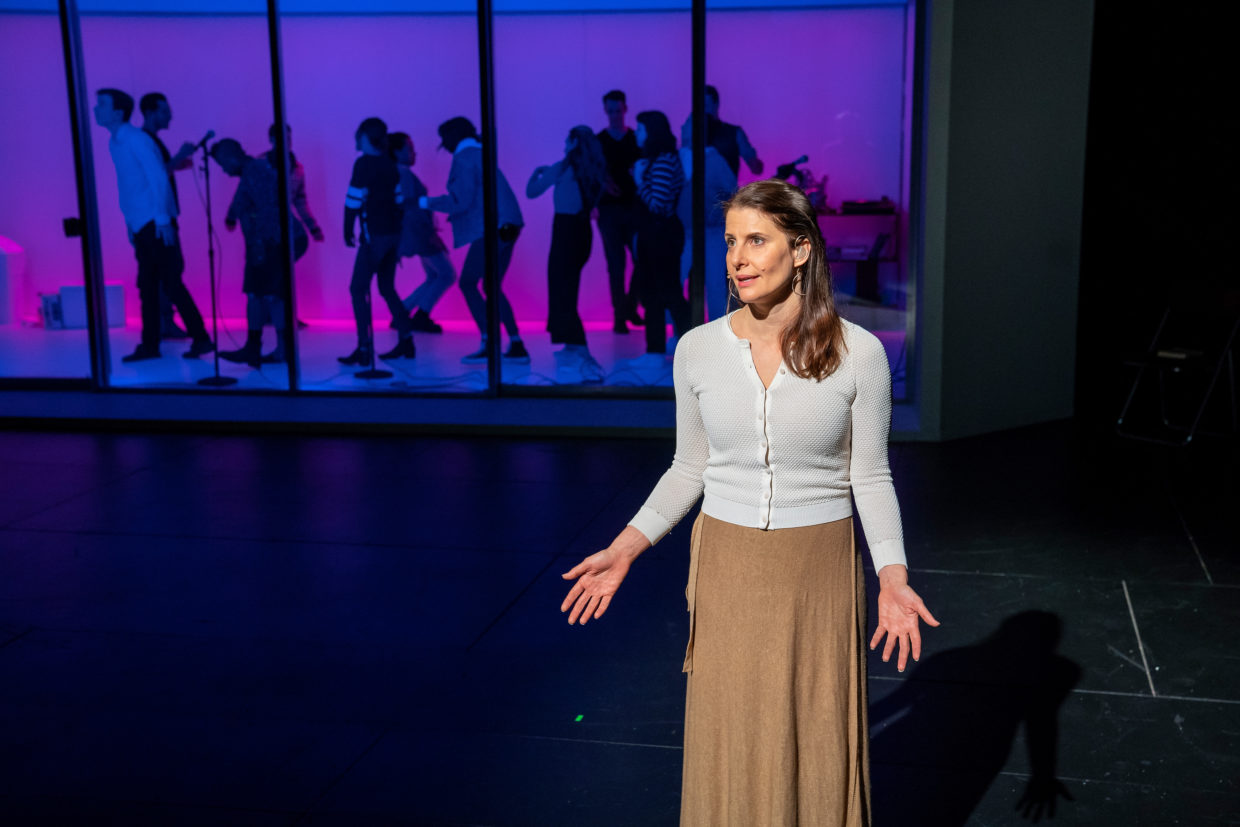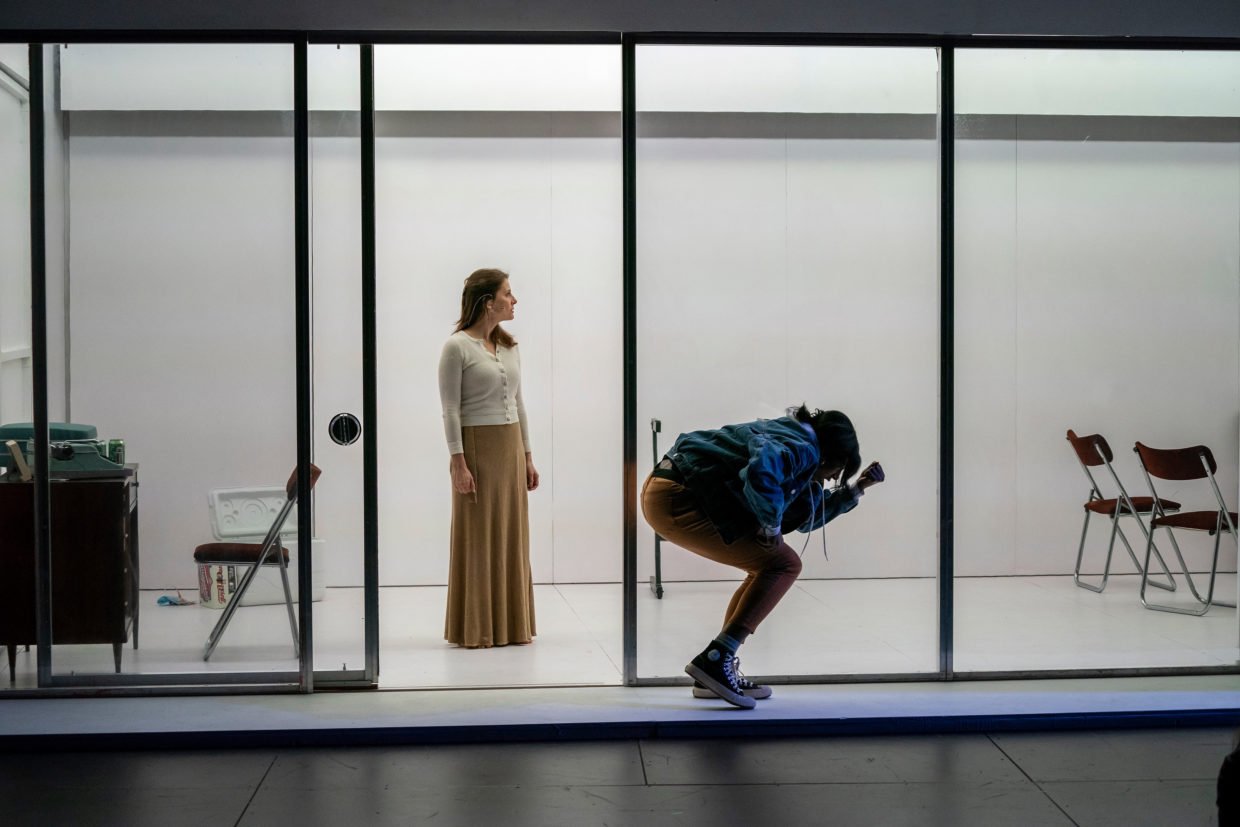
How Joan Didion's The White Album Made It to the Stage
Monika Zaleska Talks to Director Lars Jan
All photos by Stephanie Berger.
This month saw the production of the second-ever adaptation of Joan Didion’s work for the stage. Lars Jan’s sparse, contemporary take on her essay “The White Album” premiered at the Next Wave Festival at Brooklyn’s BAM Harvey Theater and will move on to Los Angeles in the spring where it will be presented at the Center for the Art of Performance at UCLA. In Jan’s adaptation, Mia Barron performs the bulk of the essay as a monologue, inhabiting Didion’s voice and person as she reports on the Huey Newton Trial, a Doors recording session, the San Francisco State College student protests, the Manson Murders as well as her own state of mind in the late, cataclysmic years of the 1960s. Below, Jan explains how Didion’s famous piece of New Journalism became a play that looks beyond that era to examine how the social and political issues of 1968 reverberate into our present day.
![]()
Monika Zaleska: I know that you are a longtime Didion fan, and that it wasn’t easy to get the rights to adapt “The White Album” for the stage. It was also your first time adapting a literary work for the theater. How did this show come together?
Lars Jan: I’ve directed mostly things I’ve written myself, so this is the most elevated, ambitious text that I’ve ever worked with. In many ways I consider “The White Album” to be a masterpiece. It is an essay, but in many ways it feels very theatrical, like a direct address monologue. Didion herself, when she was a kid, wanted to be an actress. And she uses theater metaphors throughout the essay, the idea of “missing cues,” or feelings as though she should have a script, and also from cinema, writing about 1968 as a “cutting room experience.” She’s thinking about performativity in her writing. One of the ways we were able to get the rights to the essay was that we promised to do every word. We weren’t going to cut anything—we were going to start with the first word and end with the last.
I’d tried to get the rights for seven or eight years, sending out emails that went unanswered. Then Executive Producer of the BAM Next Wave Festival Joe Melillo said, “I’d really love you to do something here, what would you like to do?” I’d never really been asked that question before—it was a career highlight. I said, “The White Album.” So they got the ball rolling, getting me in touch with Joan Didion’s agent. But we couldn’t get a green light. It wasn’t until Mia reached out to Didion’s nephew, Griffin Dunne, who with faith in the idea expressed to him, went over Joan’s apartment later that afternoon. Then we got a call from her representatives, who sounded pretty surprised as they said, “You’re never going to believe this, but you have the green light.”
MZ: As an essay, “The White Album” is made up of cutting room snippets, as you mentioned, and it presents many disparate scenes and moments from 1968. In your show, there’s a bare stage with this stark Californian house, designed by P-A-T-T-E-R-N-S architectural firm from Los Angeles, as the centerpiece of the action. How did you make a cohesive show out of such an anecdotal and far-reaching piece of writing?
LJ: One of the brilliant aspects of the essay is its collage form—collage and montage and various types of simultaneous layering or unexpected, arrhythmic juxtaposition. If there is a central location in the essay, I’d say it’s her house on Franklin Avenue, which is a few miles from where I live in Hollywood. But on stage the house takes on many different characteristics: it becomes The Doors recording studio, a courthouse, and then the location of a contemporary house party. I’m really responding to Didion’s idea of the “shifting phantasmagoria that is our actual experience.” So it’s a nonlinear, almost magical, at-times-impossible landscape. I used that idea as a lens through which to build the work.
 A scene from “The White Album” by Joan Didion created by Lars Jan.
A scene from “The White Album” by Joan Didion created by Lars Jan.
MZ: You have one actor, Mia Barron, essentially performing the entire essay as a monologue with other actors stepping into to play certain supporting roles. She’s also listed as a co-creator on the program. Could you tell me how you worked together to create this piece?
LJ: Mia is my partner, so we’re collaborators in life, but this is our first artistic collaboration. I knew it was going to take a lot of skill with language to inhabit someone as complex as Didion and make the larger experience work. In our show there’s one person delivering ninety-five percent of the language. You have to be able to stick with them for an hour and a half. Mia is an actress unquestionably capable of that. I knew this was a perfect marriage of her brain and Didion’s, her talents and Didion’s talents. To get started, we did a first family residency at Headlands Center for the Arts and brought our daughter with us. One of the goals of the project was to see if we could continue to have fulfilling artistic lives but also see each other consistently and have our child involved. There’s also a lot of work that Mia did on her own with the text and I did with other collaborators. Throughout the development process we started putting the pieces together and we’d have conversations, in and out of rehearsal, about how that was working.
MZ: Actors Andrew Schneider and Sharon Udoh inhabit iconic figures of the late 1960s in the play—Jim Morrison of The Doors and Huey Newton of the Black Panthers respectively. How do you put on a show about this time period that feels new, especially since these figures are so well known? And how do you make it resonant with our contemporary moment?
LJ: It really started with the fact that Mia Barron is not playing Joan Didion. She is using the words of the text to create a character, to speak those words instinctively. So Andrew Schneider sings the lines Jim Morrison did, but he isn’t playing Jim Morrison, he’s trying to figure out how to bring those words to life in that moment. One of the most powerful moments in the piece for me is when Sharon, playing Newton, quotes James Baldwin saying “to be black and conscious in America is to be a constant state of rage.” It’s Newton delivering Baldwin by way of Didion, and now it’s by way of Sharon Udoh at BAM. The piece is about the late 1960s, especially 1968, but it was written between 1968 and 1978 so there’s a sort of historical perspective already built into the essay itself—and now it’s 2018. We were thinking about time and the rhyming of history. I wanted to bring 2018 into the conversation visually, choreographically and dynamically with this language from a different period.
 Mia Barron, lead performer in “The White Album” by Joan Didion created by Lars Jan.
Mia Barron, lead performer in “The White Album” by Joan Didion created by Lars Jan.
MZ: At the climax of the show there is a shooting between a police officer and another actor, Micaela Taylor, who feebly attempts to shoot back by making her hand into a gun. This prolonged scene, which becomes bloody and brutal as it progresses, seems to stand in for much of the off-stage violence in Didion’s essay, such as the Manson and Navarro murders, as well as the violence against student protestors at San Francisco State.
LJ: In the center of the essay there are a couple places where Didion talks about the Black Panthers, but she doesn’t really speak to their grievances. Shortly there after, she goes to San Francisco State and again doesn’t quite take the student protestors seriously. She doesn’t give much attention to the real brutality and violence of the police reaction to the protests. Then she moves onto the Manson murders, which is the thing that really gets to her. That’s what hits close to home for her. But I think that the Manson case is much less scary than the kind of institutional violence that’s driving the student protestors and the Black Panther movement. I wanted to continue the train of logic that she begins in the essay, but doesn’t complete, which is that this is where those movements come from—structural as opposed to random violence.
MZ: Watching the show, it was disheartening at times to hear how dismissive Didion is of the student protests, or at least to hear that her attitude was ambivalent. She says that there’s no way to make sense of it of the era, that it had no intelligible narrative or significance. You don’t seem to agree with that assessment.
LJ: In some places I’m trying to harmonize with her voice and in others I’m allowing there to be a historical and individual dissonance. But Joan Didion herself was a shifting personality between 1968 and 1978, just like we all are over the course of a decade, and later, her consciousness changed massively. I’m also acknowledging that “The White Album” is a time capsule. It was over 50 years ago. The essays says over and over again that there’s no narrative [to 1968], that the pieces don’t make any sense when you add them up. I think that the lady protests too much. The articulation of the struggle to create meaning, the feeling of being unable to put the pieces together, is meaningful art.
MZ: There’s also something very innovative—but less obvious to the seated audience—going on with the staging of this piece. You have young students, activists, and artists who’ve come to see the play functioning as extras on stage and as an “inner audience.” They are on stage during some of the scenes, but also have earpieces through which they hear archival recordings of music, Black Panther rallies, and other directions for how to experience the show that are unavailable to the audience at large.
LJ: So when the house is open and the people start coming into the theater a half hour before the show, the inner audience’s experience has already started. They’re listening to audio instructions, they’re looking at a printed exhibition, they’re looking through Joan Didion’s suitcase in the room, and at the records and the bookshelf. They’re looking at the dramaturgical books inside the book. They are having a lot of experiences the outer audience will never know. I think what’s not clear to the outer audience is who those people are: they’re people in their twenties who are getting a free ticket to see a show which is more participatory. Articulating that or making it clearer would have made the experience more evolved, as well as the conversations we had after the play. Not a talkback—we’re more interested in having the different generations and perspectives in the audience talk to each other after seeing the show.
 Mia Barron and Micaela Taylor in a scene from “The White Album” by Joan Didion created by Lars Jan/ Early Morning Opera at the BAM Harvey Theater
Mia Barron and Micaela Taylor in a scene from “The White Album” by Joan Didion created by Lars Jan/ Early Morning Opera at the BAM Harvey Theater
MZ: There’s this lovely moment at the end of the play where Mia Barron goes into the house, which has filled up with fog, and reemerges on the roof. I’d love if you could talk about the staging of that last scene.
LJ: At the beginning of the play, she talks about this naked woman on the ledge who is seemingly going to commit suicide and she wonders why. It’s one of the only things that’s really repeated in the essay, but later she’s no longer interested in why, just obsessed with the picture of it. In my reading of the essay, Didion’s projecting herself inside that person’s experience and trying to feel the there-ness as opposed to the why-ness if it. In the design we were trying to evoke that by placing her in the floodlights. The fog, or cloudscape, is a kind of oblivion. As she’s standing on top of the house, the room below has become full of fog and these electric synapses are firing at her feet, as if it’s her brain. Joan Didion has this remarkable, beautiful brain, and yes with a particular historical and identity-based perspective, but nonetheless, a remarkable brain. And we are just trying to channel her voice.
Monika Zaleska
Monika Zaleska is a writer, editor, and translator as well as a recent graduate of the MFA program at Brooklyn College. She runs Reader's Report, a newsletter featuring reflections on reading by contributors and friends.



















